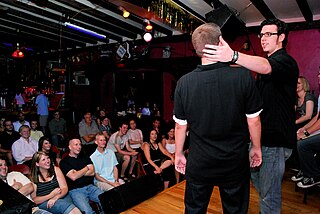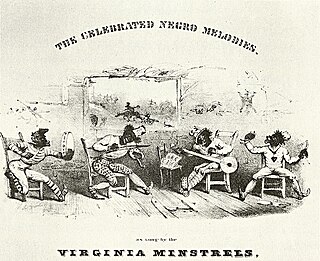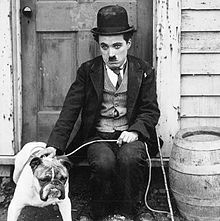
Slapstick is a style of humor involving exaggerated physical activity that exceeds the boundaries of normal physical comedy. Slapstick may involve both intentional violence and violence by mishap, often resulting from inept use of props such as saws and ladders.
Throughout film, television, and radio, British comedy has become known for its consistently peculiar characters, plots, and settings, and has produced some of the most renowned comedians and characters in the world.

Stand-up comedy is a type of comedy performance directed to a live audience in which the performer stands on a stage and delivers humorous and satirical monologues, with occasional physical acts. The performance is usually a rhetorical sketch with rehearsed scripts, but many performers also employ varying degrees of live crowd interaction as part of their routine. Stand-up comedy consists of one-liners, stories, observations, or shticks that may incorporate props, music, impressions, magic tricks, or ventriloquism.

A comedy club is a venue where a variety of comedic acts perform to a live audience. Although the term usually refers to establishments that feature stand-up comedians, it can also feature other forms of comedy such as improvisational comedians, impersonators, impressionists, magicians and ventriloquists.

Jerome Allen Seinfeld is an American stand-up comedian, actor, writer, and producer. From 1989 to 1998, he played a semi-fictionalized version of himself in the sitcom Seinfeld, which he created and wrote with Larry David. The show aired on NBC from 1989 until 1998, becoming one of the most acclaimed and popular sitcoms of all time. As a stand-up comedian, Seinfeld specializes in observational comedy. In 2004, Comedy Central named him the 12th-greatest stand-up comedian of all time.

The minstrel show, also called minstrelsy, was an American form of theater developed in the early 19th century. The shows were performed by mostly white actors wearing blackface makeup for the purpose of comically portraying racial stereotypes of African Americans. There were also some African-American performers and black-only minstrel groups that formed and toured. Minstrel shows stereotyped blacks as dimwitted, lazy, buffoonish, cowardly, superstitious, and happy-go-lucky. Each show consisted of comic skits, variety acts, dancing, and music performances that depicted people specifically of African descent.
Brian Joseph Regan is an American stand-up comedian who uses observational, sarcastic, and self-deprecating humor. He is known for incorporating body language and facial expressions into his act. His performances are often described as clean as he refrains from profanity as well as taboo subject matter. Regan's material typically covers everyday events, such as shipping a package with UPS, mortgages, and visits to the optometrist. While he does not define himself as youth-oriented, Regan makes frequent references to childhood, including little league baseball, grade school spelling bees, and science projects.

Frederick John Westcott, best known by his stage name Fred Karno, was an English theatre impresario of the British music hall. As a comedian of slapstick he is credited with popularising the custard-pie-in-the-face gag. During the 1890s, in order to circumvent stage censorship, Karno developed a form of sketch comedy without dialogue.
Radio comedy, or comedic radio programming, is a radio broadcast that may involve variety show, sitcom elements, sketches, and various types of comedy found in other media. It may also include more surreal or fantastic elements, as these can be conveyed on a small budget with just a few sound effects or some simple dialogue. Radio comedy began in the United States in 1930, based on the fact that as most United Kingdom music hall comedians such as Charlie Chaplin and Stan Laurel progressed to silent films, they moved to Hollywood and fed the radio comedy field. Another British music hall comic, George Formby, stayed in the British movie industry, and in 1940 joined the Entertainments National Service Association to entertain British World War II troops. UK radio comedy therefore started later, in the 1950s.
Comic timing or comedic timing emerges from a performer's joke delivery: they interact with an audience—intonation, rhythm, cadence, tempo, and pausing—to guide the audience's laughter, which then guides the comedic narrative. The pacing of the delivery of a joke can have a strong impact on its comedic effect, even altering its meaning; the same can also be true of more physical comedy such as slapstick. Comic timing is also crucial for comedic video editing to maximize the impact of a joke, for example, through a smash cut.

A double act is a form of comedy originating in the British music hall tradition, and American vaudeville, in which two comedians perform together as a single act, often highlighting differences in their characters' personalities. Pairings are typically long-term, in some cases for the artists' entire careers. Double acts perform on the stage, television and film.

Stan Laurel was an English comic actor, writer and film director who was one half of the comedy duo Laurel and Hardy. He appeared with his comedy partner Oliver Hardy in 107 short films, feature films and cameo roles.

George Henry Wallace is an American comedian and actor. Wallace has had supporting roles in a number of films, including 3 Strikes and the Coen Brothers film The Ladykillers. Wallace also appeared in Batman Forever (1995) as the Mayor of Gotham City. Other film credits include A Rage in Harlem (1991), The Wash (2001), Punchline (1988), Things Are Tough All Over (1982), Postcards from the Edge (1990), and Mr. Deeds (2002).
Observational comedy is a form of humor based on the commonplace aspects of everyday life. It is one of the main types of humor in stand-up comedy. In an observational comedy act, the comedian makes an observation about something which is common enough to be familiar to their audience, but not commonly discussed. Such observations are typically presented with the phrase "Have you ever noticed...?" or "Did you ever notice...?" which has become a comedy cliché.
American humor refers collectively to the conventions and common threads that tie together humor in the United States. It is often defined in comparison to the humor of another country – for example, how it is different from British humor and Canadian humor. It is, however, difficult to say what makes a particular type or subject of humor particularly American. Humor usually concerns aspects of American culture, and depends on the historical and current development of the country's culture. The extent to which an individual will personally find something humorous obviously depends on a host of absolute and relative variables, including, but not limited to geographical location, culture, maturity, level of education, and context. People of different countries will therefore find different situations funny. Just as American culture has many aspects which differ from other nations, these cultural differences may be a barrier to how humor translates to other countries.

Carol Leifer is an American comedian, writer and producer whose career as a stand-up comedian started in the 1970s when she was in college. She has written many television scripts including The Larry Sanders Show, Saturday Night Live and Seinfeld. She has received four Primetime Emmy Award nominations for The Larry Sanders Show, Seinfeld, the 82nd Academy Awards and the 84th Academy Awards. Leifer's inner-monologue driven, observational style is often autobiographical, encompassing subjects about her Jewish ancestry and upbringing, coming out, same-sex marriage, relationships and parenting.
The stump speech was a comic monologue from blackface minstrelsy. A typical stump speech consisted of malapropisms, nonsense sentences, and puns delivered in a parodied version of Black Vernacular English. The stump speaker wore blackface makeup and moved about like a clown. Topics varied from pure nonsense to parodies of politics, science, and social issues. Although both the topic itself and the black character's inability to comprehend it served as sources of comedy to white people, minstrels used such speeches to deliver racist social commentary. The stump speech was a precursor to modern stand-up comedy.

Comedy is a genre of fiction that consists of discourses or works intended to be humorous or amusing by inducing laughter, especially in theatre, film, stand-up comedy, television, radio, books, or any other entertainment medium. The term originated in ancient Greece: In Athenian democracy, the public opinion of voters was influenced by political satire performed by comic poets in theaters. The theatrical genre of Greek comedy can be described as a dramatic performance pitting two groups, ages, genders, or societies against each other in an amusing agon or conflict. Northrop Frye depicted these two opposing sides as a "Society of Youth" and a "Society of the Old". A revised view characterizes the essential agon of comedy as a struggle between a relatively powerless youth and the societal conventions posing obstacles to his hopes. In this struggle, the youth then becomes constrained by his lack of social authority, and is left with little choice but to resort to ruses which engender dramatic irony, which provokes laughter.

American burlesque is a genre of variety show derived from elements of Victorian burlesque, music hall, and minstrel shows. Burlesque became popular in the United States in the late 1860s and slowly evolved to feature ribald comedy and female nudity. By the late 1920s, the striptease element overshadowed the comedy and subjected burlesque to extensive local legislation. Burlesque gradually lost its popularity, beginning in the 1940s. A number of producers sought to capitalize on nostalgia for the entertainment by recreating burlesque on the stage and in Hollywood films from the 1930s to the 1960s. There has been a resurgence of interest in this format since the 1990s.
The roots of modern stand-up comedy began in 1840s minstrel shows that perpetuated racist stereotypes in the United States. There were, however, African-American and other all-black minstrel groups which formed and toured. American vaudeville emerged around the same time and along with the later developed Chitlin' Circuit, produced the founders of this form of entertainment. Early stand-up comedians spoke directly to the audience as themselves without props or costumes, which distinguished these acts from vaudeville performances. These comics stood in front of the curtain during their shows, like early 20th century "front cloth" stand-up comics in Britain and Ireland whose numbers allowed the stage behind them to be re-set for another act.















